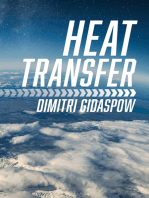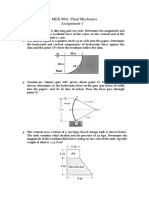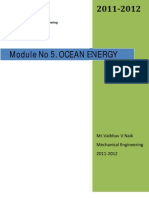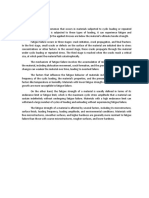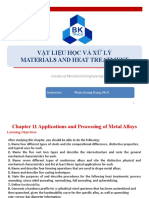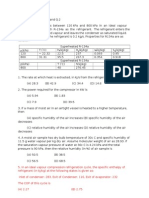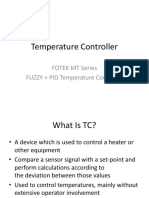HMT Unit 1
HMT Unit 1
Uploaded by
rp0212Copyright:
Available Formats
HMT Unit 1
HMT Unit 1
Uploaded by
rp0212Original Title
Copyright
Available Formats
Share this document
Did you find this document useful?
Is this content inappropriate?
Copyright:
Available Formats
HMT Unit 1
HMT Unit 1
Uploaded by
rp0212Copyright:
Available Formats
DEPARTMENT OF MECHANICAL ENGINEERING HEAT AND MASS TRANSFER-2251 UNIT-I (TWO MARKS QUESTIONS) CONDUCTION 1. Define heat transfer?
2. Mention the significance of the study of heat transfer. 3. Give some examples for heat transfer in engineering. 4. What is the difference between thermodynamics and heat transfer? 5. What are the different modes of heat transfer? 6. Define conduction? 7. Define convection? 8. Define radiation? 9. Define heat flux. 10. State Fourier law of heat conduction. 11. Define thermal conductivity. 12. Discuss the effects of temperature on thermal conductivity. 13. State the assumptions followed in Fouriers series law of conduction 14. What are the significance of Fouriers law 15. Mention the various factors affecting the thermal conductivity of a material. 16. State the dependence of thermal conductivity on temperature. 17. Define thermal conduction resistance. 18. Write the general heat conduction equation in Cartesian co-ordinates 19. Write the general heat conduction equation in Cartesian co-ordinates for an isotropic material. 20. Write the general heat conduction equation in Cartesian co-ordinates for an isotropic material without internal heat generation.
21. Write the general heat conduction equation in polar Co-ordinates for an isotropic material. 22. Write the general heat conduction equation in spherical co-ordinates. 23. Define steady state heat conduction 24. Define transient heat conduction 25. Define transient heat conduction 26. Write the general differential equation in Cartesian co-ordinates for a steady state heat conduction through an isotropic material without internal heat generations 27. Difference between thermodynamics and heat transfer. 28. Define the basic law governing heat transfer 29. Define thermal conductivity of materials 30. Define thermal resistance 31. Write down the three dimensional heat conduction equation in rectangular coordinate system 32. Distinguish between steady state and un steady heat conduction 33. Write the effects of thermal conductivity 34. What is the overall heat transfer co-efficient 35. Define critical radius of insulation 36. What is mean by fin 37. What are the types of fins 38. Calculate the rate of heat transfer per unit area through a copper plate of 45mm thick ,whose face is maintained at 350and other face at 50.take k=370W/mk. 39. Define efficiency fin 40. Define effectiveness of fin 41. Define penetration depth. 42. Define semi-infinite solid. 43. How will you increase the response of a thermocouple?
44. What are Heisler chart? 45. What are the methods available to solve the transient heat conduction problems? 46. Define cooling process. 47. Define lumped heat capacity analysis. 48. Write the relation between efficiency of the fin and effectiveness of the fin. 49. Mention some of the applications of transient heat conduction. 50. What are the applications of fins? 51. Mention some common types of fin configurations available. 52. Define Biot number. 53. List down the three types of boundary conditions. 54. Write down the equation for conduction of heat through a hollow cylinder 55. write down the equation for conduction of heat through a slab or plane wall 56. A temperature difference of 500 C is applied across a fire-clay brick, 10cm thick having a thermal conductivity of 1W/mK. Find the heat transfer rate per unit area 57. Define Newton Rikhmans law 58. Which one of the following is not a material property? 59. Name some good and some poor conductors of heat. 60. State the applications of fins. 61. What are the factors affecting the thermal conductivity? 62. State Newtons law of cooling. 63. What is lumped capacity analysis? 64. Calculate the rate of heat transfer per unit area through a copper plate 45mm thick, whose one face is maintained at 50oC.take the k of the copper as 370W/moC. 65. A plane wall is 150mm thick and its wall area is 4.5m2.if its conductivity is 9.35W/moC and surface temperature are steady at 150oCand 45oC, determine the heat flow across the plane wall.
66. A plane wall is 250mm thick and its wall area is 6.5m2.if its conductivity is 10.35W/moC and surface temperature are steady at 150oCand 45oC, determine the temperature gradient in the flow direction assume that Q=29452.5W 67. Determine the heat flow across a plane wall of 10cm thickness with a thermal conductivity of 8.5 W/mK when the surface temperature are steady at 100oc and 30oC.the wall area is 3m2.also find the temperature gradient in the flow direction. 68. Determine the heat transfer by convection over a surface of 0.5m2 if the surface is at 160oC and fluid is at 40oC.the value of convective heat transfer coefficient is 25W/m2K. 69. A surface is at 200oC and has an of 2m2.it exchanges heat with another surface B at 30oC by radiation. The value of factor due to the with another surface at 30oC by radiation. The value factor due to the geometric location and emissivity is 0.46.determine the heat exchange. 70. A cube shaped solid 20cm side having a density of 2500kg/m3 and specific heat of 0.52kj/kgK has a uniform heat generation rate of 100kj/m3. If the heat received over its surfaces at240W, determine the time rate of temperature change of the solid. 71. A wire1.5 mm diameter and 150mm long is submerged in water at atmospheric pressure. An electric current is passed through a wire and is increased until the water boils at 100oC .under the condition if convective heat transfer coefficient is 4500w/m2oC.Find how much electric power must be supplied to the wire to maintain the wire surface at 120oC 72. Draw the P-V diagram for cycle operation. 73. What is meant by closed system in heat transfer? 74. What is meant by open system in heat transfer? 75. What is the mechanism used in conduction in solids? 76. Give any two modes of heat conduction in liquids and gases 77. Name any four thermal conductivity materials with their thermal conductivity. 78. Draw any two types of fins. Define heat? 79. Why it is necessary to evaluate fin performance and write the methods for fin evaluation. 80. Give some examples of heat transfer in engineering 81.Give some examples of conduction in day to day life.
PART B (16 MARKS) CONDUCTION 1. (a) Derive the general heat conduction equation in Cartesian coordinates (b) An exterior wall of a house may be approximately by a 0.1 m layer of common brick (k= 0.7 W/m oC) followed by a 0.04 m layer of gypsum plaster (k= 0.48 W/m o C). What thickness of loosely packed rock wool insulation (k= 0.0065 W/m oC) should be added to reduce the heat loss or gain through the wall by 80%. 2. The temperature distribution across a large concrete slab (k= 1.2 W/m oC, = 1.77 * 10-3 m2/h) 500 mm thick heated from one side as measured by thermocouples approximates to the relation t= 60-50x+12x2+20x3-15x4 wheret is in oC and x is in meters. Considering an area of 5 m2 compute. 1. The heat entering and leaving the slabs in time time. 2. The heat energy stored in unit time. 3. The rate of temperature change at both sides of the slabs. 4. The point where the rate of heating or cooling is maximum. 3. (a) Explain the different modes of heat transfer with appropriate expressions. ( i.) conduction (ii). Convection( iii.) Radiation (iv). Fourier law of conduction. (v.) Stefan-Boltzmann law (b) Composite wall consist of 10 cm thick layer of building brick, K= 0.7 W/mK and 3 cm thick plaster, k= 0.5 W/mK. An insulating material of K= 0.08 W/mK is to be added to reduce the heat transfer through the wall by 40%. Find its thickness. 4. Circumferential aluminum fins of rectangular profile (1.5 cm wide and 1 mm thick) are on to a 90mm engine cylinder with a pitch of 10mm. the height of the cylinder is fitting the fins are 200oC and 150oC respectively. Take ambient at 30oC and h (average) = 100 W/m2 K. Estimate the heat dissipated from the finned and the unfinned surface areas of cylinders body. 5. (a) What do you understand by critical radius of insulation; obtain an expression for the same. (b) A cylinder 1m long and 5 cm in diameter is placed in an atmosphere at 45oC. It is provided with 10 longitudinal straight fins of material having k= 120 W/mK. The height of 0.76 mm thick fins is 1.27 cm from the cylinder ,the heat transfer coefficient
between and atmospheric air is 17 W/m2K. Calculate the rate of heat transfer and the temperature at the end of Fins if surface temperature of cylinder is 150oC. 6. (a) A steel tube with 5cm ID, 7.6 cm OD and k= 15W/m oC is covered with an insulative covering of thickness 2 cm and k=0.2W/moC. A hot gas at 330oC with h=400 W/moC. Flows inside the tube. The outer surface of the insulation is exposed to cool air at 30oC with h=60 W/m2oC. Calculate the heat losses from the tube to the air for 10m of the tube and the temperature drops resulting from the thermal rsistance of the hot gas flow, the steel tube, the insulation layer and the outside air. (b) The inner surface at r = a and the outer surface at r=b of a hollow cylinder are at maintained at uniform temperature T1 and T2 resp. The thermal conductivity of the solid is constant develop an expression for the 1 dimensional steady state temperature distribution in the cylinder and for the radial heat flow rate through the cylinder over a length H. 7. (a) What is lumped capacity analysis and obtain the expression for the temperature distribution for same. b) A slab of aluminum 10 cm thick is originally at a temperature of 500 oC is suddenly immersed in a liquid at 100oC resulting in heat transfer coefficient of 1200W/m2K. Determine the temperature at the center line and the surface one min after the immersion Also calculate the total thermal energy removed per unit area of the slab during this period. The properties of aluminum for the given condition are =8.4*10 -5 m2/s; = 2700 kg/m3; = 215W/mK; c= 0.9kg/K. 8. (a) A composite wall consist of 10 cm thick layer off brick.k=0.7 W/mK and 3cm thick plaster, k=0.5 W/mK. An insulating material of k=0.08 W/mK is to be added to reduce the heat transfer through the wall by 40%.Find its thickness. (b) An aluminum plate (k=160W/moC, =2790W/moC, Cp=0.88kJ/kgoC) of thickness L=3cm and at a uniform temperature of 2225 oC is suddenly immersed at time t=0 in a well stirred fluid maintained at a constant temperature T =25oC. Take=320oC.Determine the time required for the centre of the plate to reach 50oC. 9. (a) A furnace wall consists of three layers. The inner layer of 10cm thickness is made of firebrick (k=1.04W/mK).The intermediate layer of 25cm thickness is made of masonry brick (k= 0.69W/mK) followed by a 5cm thick Concrete wall (k=1.37W/mK. When the furnace is in continues operation the inner surface of the furnace is at 800oC while the outer concrete surface is at 50oC. Calculate the rate of heat loss per unit area of the wall, the temperature at the inter face of the firebrick and masonry brick and the temperature at the interface of the masonry brick and concrete. (b) An electrical wire of 10cm length and 1mm diameter dissipates 200 W in air at 25oC.the convection heat transfer coefficient between the wire surface and air is 15
W/m2K.Calulate the critical radius of insulation and also determines the temperature of the wire if its insulated to the critical thickness of insulation. 10. (a) An aluminum rod (k=204 W/mK) 2cm in diameter and 20cm long protrudes from a wall which is maintained at 300oC.the end of the rod is insulated and the surface of the rod is exposed to air at 30 oC.the heat transfer coefficient between the rods surface and air is 10W/mK. Calculate the heat lost by the rod and the temperature of the rod at a distance of 10 cm from the wall. . 11. Find out the amount of heat transferred through an iron fin of length 50 mm, width 100 mm and the thickness 5 mm. Assume k=58w/moC and h=12W/m2C for the material of the fin and the temperature at the base of the fin as 80oC Also find the temperature at the tip of the fin if the atmospheric temperature is 20oC. 12. An electrical wire of 10 m length and 1mm diameter dissipates 200W in air at 25oc. The convection heat transfer coefficient between the wire surface and air is 15W/m2K. Calculate the critical radius insulation and also determine the temperature of the wire if its insulated to the critical thickness of insulation. 13. (a) Derive the heat conduction equation in the cylindrical co-ordinates using the elemental volume for a stationary isotropic solid. (b) A 3 cm OD steam pipe is to be covered with two layer of insulation each having a thickness of 2.5 cm. the average thermal conductivity of one insulation is 5 times that of the other. Determine the percentage decrease in heat transfer if better insulating material is next to pipe than it is the outer layer. Assume that the outside and inside temperatures of composite insulation are fixed.
14. A composite wall is formed of 2.5 cm copper plate (k=355W/mk),a 3.2 mm layer of asbestos(k=.110W/mK) and a 5cm layer of fibre plate (k=.049W/mK).The wall is subjected to an overall temperature difference of 560 o C (560 O C on the Cu plate side and 0 O C on the fibre plate side ).Estimate the heat flux through this composite wall and the interface temperature between asbestos and fibre plate. 15. A Steel tube of 5cm ID ,7.6cm OD and k=15W/mK is covered with an insulation of thickness 2cm and thermal conductivity ,0.2 W/mK.A hot gas at 330 O C and h=60W/m2 K.Assuming a tube length of 10m,find the heat loss from the tube to air. Also find,across which layer the largest temperature drop occurs. 16. One end of long rod 1cm diameter having a thermal conductivity of45W/mK is placed in a furnace. The rod is exposed to air at 30 O C over its surface and the convection co-efficient is estimated at 35W/m2K.If the temperature is read as 265 O C at a distance of 39.3mm from the furnace end,determine the best temperature of the rod.
17. A plane shaped nuclear fuel element of 24 mm thickness exposed on the sides to convection at 200 O C with a convective heat transfer co-efficient of 900W/m2K generates heat at 20 MW/m3.Determine (i) The surface temperature,(ii) the maximum temperature in the plate and (iii) the temperature gradient at the surface. The thermal conductivity of the material is 25W/mK. 18. A steel pipe of 0.4m dia. carrying oil in the cold region is proposed to be protected by insulations A and B of 8cm and 10cm thickness with conductivities of 0.03and 0.3 W/m K. These are purchased in required volumes in powder form. During the execution, by mistake the material B with conductivity 0.3W/mK was applied first and then the other material. Investigate the heat transfer rate in two situations.
19. Obtain an expression for the temperature profile of an infinitely long fin of uniform crosssection from basic principles and hence calculate the heat transfer by fin. 20. A thermocouple is moved from one medium to another medium at a different temperature, sufficient time must be given to the thermocouple to come to thermal equilibrium with the new conditions before a reading is taken. consider a 0.1 dia copper thermocouple wire originally at 150oC. Find the temperature response (i.e., an approximate plot of temperature Vs time for intervals of ( 40 and 120 seconds) when this wire is suddenly immersed in (i) water at O 40 C (h=80W/m2K)(ii)air at 40OC (h=40W/m2K)
You might also like
- Artificial Unintelligence How Computers Misunderst... - (PG 100 - 100)Document1 pageArtificial Unintelligence How Computers Misunderst... - (PG 100 - 100)IELTS Abu DhabiNo ratings yet
- Digital Assignment 1Document1 pageDigital Assignment 1Arvind GiridharNo ratings yet
- Conduction Problems & Solutions Conduction Problems & SolutionsDocument30 pagesConduction Problems & Solutions Conduction Problems & SolutionsRoronoaNo ratings yet
- Cam and Follower: Definition, Types, Working Principle, and ApplicationsDocument17 pagesCam and Follower: Definition, Types, Working Principle, and Applicationsniaz kilamNo ratings yet
- Assignment No 1 HTDocument4 pagesAssignment No 1 HTDhiraj DhimanNo ratings yet
- MEEG 306 Tutorial Revised May 2019Document30 pagesMEEG 306 Tutorial Revised May 2019sagar100% (1)
- Chapter 7Document37 pagesChapter 7kirubel AlemuNo ratings yet
- Convection HMTDocument47 pagesConvection HMTbalakaleesNo ratings yet
- HT-026 SolutionDocument2 pagesHT-026 SolutionKTINE08No ratings yet
- Lee Method7831Document6 pagesLee Method7831Priya BharadwajNo ratings yet
- Ac/Dc Machineries: A Study Guide and Module For Third Year BSME Students of SlsuDocument58 pagesAc/Dc Machineries: A Study Guide and Module For Third Year BSME Students of Slsuosas pasasNo ratings yet
- AT6401 Applied Thermodynamics and Heat TransferDocument2 pagesAT6401 Applied Thermodynamics and Heat Transferkarthikeyan MNo ratings yet
- Gearbox Lift StandDocument72 pagesGearbox Lift StandfuadNo ratings yet
- EDA Counting RulesDocument7 pagesEDA Counting RulesMaryang DescartesNo ratings yet
- For Reference OnlyDocument2 pagesFor Reference OnlyBenmark Jabay100% (1)
- Module No 5a.ocean EnergyDocument15 pagesModule No 5a.ocean EnergyVaibhav Vithoba NaikNo ratings yet
- MODULE 2 LaboratoryDocument3 pagesMODULE 2 Laboratoryzyx xyzNo ratings yet
- Materials Engr.Document7 pagesMaterials Engr.Ryan TogononNo ratings yet
- Combined Fatigue - Numerical 4Document1 pageCombined Fatigue - Numerical 4Hemadri SubramanyaNo ratings yet
- Problem Sheet-01 ME502 IntroductionDocument2 pagesProblem Sheet-01 ME502 IntroductionDebjyoti DeyNo ratings yet
- Fatigue DeterminationDocument5 pagesFatigue DeterminationMichael JayNo ratings yet
- ME Elective 1 Engine Friction LubricationDocument7 pagesME Elective 1 Engine Friction LubricationrickyNo ratings yet
- Module 2 - Heat and ThermodynamicsDocument12 pagesModule 2 - Heat and ThermodynamicsANGELO NINO ALVARADONo ratings yet
- WasaaapppDocument29 pagesWasaaapppManoy BermeoNo ratings yet
- Hydraulics FinalDocument2 pagesHydraulics FinalAbel Aregay100% (3)
- Harmonically Excitation VibrationDocument17 pagesHarmonically Excitation VibrationCherry ObiasNo ratings yet
- (Part 3) DC GeneratorDocument34 pages(Part 3) DC GeneratorRonan RojasNo ratings yet
- Guidelines To Practice Under The Fundamental Canons of EthicsDocument21 pagesGuidelines To Practice Under The Fundamental Canons of EthicsChan Marie Camacho PielagoNo ratings yet
- ME Con-1 Mock-1Document15 pagesME Con-1 Mock-1vidya chakitwarNo ratings yet
- Week 3 Lecture 2 HTDocument6 pagesWeek 3 Lecture 2 HTdanial kashifNo ratings yet
- Angular Momentum Principles - Fluid MechanicsDocument14 pagesAngular Momentum Principles - Fluid Mechanicsing_manceraNo ratings yet
- Career Essay by Amanda MaineDocument5 pagesCareer Essay by Amanda Maineapi-294050226No ratings yet
- Notes-Fluid Flow MachineryDocument48 pagesNotes-Fluid Flow MachineryIanNo ratings yet
- Experiment No. 5-To Study The Constructional Features and Working of Pelton TurbineDocument6 pagesExperiment No. 5-To Study The Constructional Features and Working of Pelton TurbineShahedNo ratings yet
- Heat and Mass Transfer: "Solved Problems"Document16 pagesHeat and Mass Transfer: "Solved Problems"qiritical99No ratings yet
- Engineering EconomicsDocument3 pagesEngineering EconomicsCMDNo ratings yet
- Chap02 ADocument64 pagesChap02 ALUIS ISAAC LEON PARONo ratings yet
- Simple StrainDocument36 pagesSimple StrainMartina CelsoNo ratings yet
- Acquired Books Prof ENGG. 2012 2016 RevDocument27 pagesAcquired Books Prof ENGG. 2012 2016 RevFrei Magsino100% (1)
- 2.0 Midterm - Mechanics of Deformable Bodies - Thin-Walled Pressure VesselDocument25 pages2.0 Midterm - Mechanics of Deformable Bodies - Thin-Walled Pressure VesselRAQUISIAGA, KYNAH YVE A.No ratings yet
- Problems On Hydraulic Turbines (Ch-6)Document8 pagesProblems On Hydraulic Turbines (Ch-6)xan pitchuNo ratings yet
- Design and Fabrication of Paddy Cleaning MachineDocument5 pagesDesign and Fabrication of Paddy Cleaning MachineDave Rone0% (1)
- Chapter 2. Vector Operation in Analytical and Graphical MethodDocument7 pagesChapter 2. Vector Operation in Analytical and Graphical MethodRampage YT100% (1)
- CLINT E. MOSENABRE FluidsDocument5 pagesCLINT E. MOSENABRE FluidsClint MosenabreNo ratings yet
- Lecture Notes # 5: Dynamics of Rigid BodiesDocument13 pagesLecture Notes # 5: Dynamics of Rigid BodiesmymeeepNo ratings yet
- UGRD ENG6203 Engineering EconomicsDocument4 pagesUGRD ENG6203 Engineering EconomicsJitlee PapaNo ratings yet
- Pulleys and Tension: Engr. Princess Edynette L. PintoDocument16 pagesPulleys and Tension: Engr. Princess Edynette L. PintoJeromeNo ratings yet
- ES 65 Problem Solving Drill IIDocument2 pagesES 65 Problem Solving Drill IIedmark icalina100% (4)
- Sample Questions - STRENGTHDocument4 pagesSample Questions - STRENGTHEvan Carniyan0% (1)
- Paolo Castro-WEEK 3Document5 pagesPaolo Castro-WEEK 3Paolo CastroNo ratings yet
- Sheet 1 - Introduction To Fluid MechanicsDocument9 pagesSheet 1 - Introduction To Fluid MechanicsMugiwara SparrowNo ratings yet
- PQT Chapter 11 Applications and Processing of Metal AlloysDocument30 pagesPQT Chapter 11 Applications and Processing of Metal AlloysNguyễn Việt TiếnNo ratings yet
- Assignment 6Document3 pagesAssignment 6radhikaNo ratings yet
- Lab 4 Apa TahDocument5 pagesLab 4 Apa TahKhairul Anam HaliminNo ratings yet
- MCE12Lab - Material Science Laboratory ManualDocument62 pagesMCE12Lab - Material Science Laboratory ManualJaloyd MacalalagNo ratings yet
- HeatEnginesVol 2 Chapter 7 RS PDFDocument29 pagesHeatEnginesVol 2 Chapter 7 RS PDFMahesh Babu TalupulaNo ratings yet
- Act 1 Engineering Economics Group 6Document3 pagesAct 1 Engineering Economics Group 6Charlie Ercole Mercado100% (1)
- Question Bank HMTDocument18 pagesQuestion Bank HMTBhavesh KapilNo ratings yet
- ME6502Document10 pagesME6502Thulasi RamNo ratings yet
- ME1251-Heat and Mass TransferDocument11 pagesME1251-Heat and Mass Transfermanoj kumar GNo ratings yet
- Ppe Unit 2Document25 pagesPpe Unit 2rp0212No ratings yet
- Thermal Selected ListDocument2 pagesThermal Selected Listrp0212No ratings yet
- Adhiparasakthi Engineering College: Cad Cam LabDocument1 pageAdhiparasakthi Engineering College: Cad Cam Labrp0212No ratings yet
- Introduction To Convection Heat and Mass TransferDocument51 pagesIntroduction To Convection Heat and Mass Transferrp0212No ratings yet
- Labview Real-Time 1 Course Manual: SampleDocument14 pagesLabview Real-Time 1 Course Manual: Samplerp0212No ratings yet
- AtdDocument71 pagesAtdrp0212100% (1)
- 1.define Briefly About The Effect of Alloying On Steels?Document7 pages1.define Briefly About The Effect of Alloying On Steels?rp0212No ratings yet
- Gate ThermalDocument4 pagesGate Thermalrp0212No ratings yet
- 3.5fuel Cell Cogeneration SystemsDocument6 pages3.5fuel Cell Cogeneration Systemsrp0212No ratings yet
- HMT Unit2Document8 pagesHMT Unit2rp0212No ratings yet
- HMT Unit4Document8 pagesHMT Unit4rp0212100% (1)
- ME2037 Maintenance EngineeringDocument46 pagesME2037 Maintenance Engineeringrp0212100% (2)
- Efficiency of A Thermodynamic Motor at Maximum PowerDocument9 pagesEfficiency of A Thermodynamic Motor at Maximum PowerAma PredaNo ratings yet
- (IFAC Symposia Series) International Federation of Automatic Control, C. McGreavy-Dynamics and Control of Chemical Reactors and Distillation Columns. Selected Papers from the IFAC Symposium, Bournemou.pdfDocument322 pages(IFAC Symposia Series) International Federation of Automatic Control, C. McGreavy-Dynamics and Control of Chemical Reactors and Distillation Columns. Selected Papers from the IFAC Symposium, Bournemou.pdfAmino AcidNo ratings yet
- Lynkurs Prosessregulering (Crash Course Process Control)Document20 pagesLynkurs Prosessregulering (Crash Course Process Control)tryanti sinambelaNo ratings yet
- 2015 Book AdvancedModelsOfNeuralNetworksDocument296 pages2015 Book AdvancedModelsOfNeuralNetworksXandre Dmitri Clementsmith100% (4)
- Mid Term ControlDocument7 pagesMid Term ControlTony JackiNo ratings yet
- Advance ISTQBDocument31 pagesAdvance ISTQBRamakrishna BorraNo ratings yet
- Requirements Modeling (Use Case Diagram + Use Case Description) Requirements Modeling (Use Case Diagram + Use Case Description)Document48 pagesRequirements Modeling (Use Case Diagram + Use Case Description) Requirements Modeling (Use Case Diagram + Use Case Description)Joseph NugentNo ratings yet
- Jurnal Proses ManufakturDocument6 pagesJurnal Proses ManufakturNur RokhimNo ratings yet
- Software Project Management: Telone Centre For LearningDocument22 pagesSoftware Project Management: Telone Centre For LearningTamuka Tavonga MugombaNo ratings yet
- Proportional + Integral + Derivative Controller Using Op-AmpDocument8 pagesProportional + Integral + Derivative Controller Using Op-AmpdharanikaNo ratings yet
- Artifical Intelligence (10. Gopika Rawte 8B)Document14 pagesArtifical Intelligence (10. Gopika Rawte 8B)Gopika RawteNo ratings yet
- Book Reviews: RegulationDocument2 pagesBook Reviews: RegulationThành ViếtNo ratings yet
- Taha ch03 ImagesDocument17 pagesTaha ch03 ImagesMaroun Abou JaoudehNo ratings yet
- Non Functional RequirementDocument6 pagesNon Functional RequirementAdelfried Goh Khai YetNo ratings yet
- Fundamental of Software EngineeringDocument77 pagesFundamental of Software EngineeringWaqar HassanNo ratings yet
- Introduction To Discrete Time Signals & SystemDocument119 pagesIntroduction To Discrete Time Signals & SystemMahesh Abnave100% (1)
- Least Mean Square AlgorithmDocument14 pagesLeast Mean Square AlgorithmjaigodaraNo ratings yet
- Temperature ControllerDocument22 pagesTemperature ControllernehalNo ratings yet
- Introduction To Software EngineeringDocument6 pagesIntroduction To Software EngineeringmiranahumasaNo ratings yet
- CS Set1 ESEDocument2 pagesCS Set1 ESEajinkya bhagatNo ratings yet
- 2018 IJBC Matlab Lyapunov Exponents Fractional Order SystemsDocument15 pages2018 IJBC Matlab Lyapunov Exponents Fractional Order Systemsahmed rafatNo ratings yet
- Dbms Notes Unit IDocument9 pagesDbms Notes Unit IVAIBHAV SWAMINo ratings yet
- 11 - BE-VI Sem - Introduction To Machine Learning - ITDocument1 page11 - BE-VI Sem - Introduction To Machine Learning - ITShashank RocksNo ratings yet
- Basic Concept of Process Control SystemDocument29 pagesBasic Concept of Process Control Systemhabtemariam mollaNo ratings yet
- 04 Transfer FunctionDocument4 pages04 Transfer FunctionJosue MarshallNo ratings yet
- Critics of Open System TheoryDocument6 pagesCritics of Open System TheoryOlanrewaju Rasheed OpeyemiNo ratings yet
- Chapter 3 and 4 - Reliability, Maintainability, and Availability of Facilities and The Assessment and Control of Product Reliability - 2019Document35 pagesChapter 3 and 4 - Reliability, Maintainability, and Availability of Facilities and The Assessment and Control of Product Reliability - 2019endalkachewNo ratings yet
- SAD - Ch11 - Case StudyDocument45 pagesSAD - Ch11 - Case StudyLÊ HỮU ĐẠTNo ratings yet
- A Survey of Software Development Process Models in Software EngineeringDocument11 pagesA Survey of Software Development Process Models in Software Engineeringاحمد رياض عبداللهNo ratings yet

